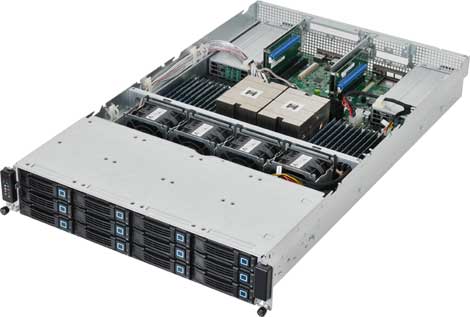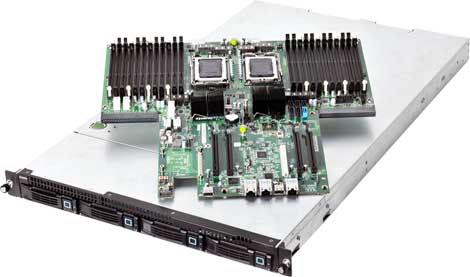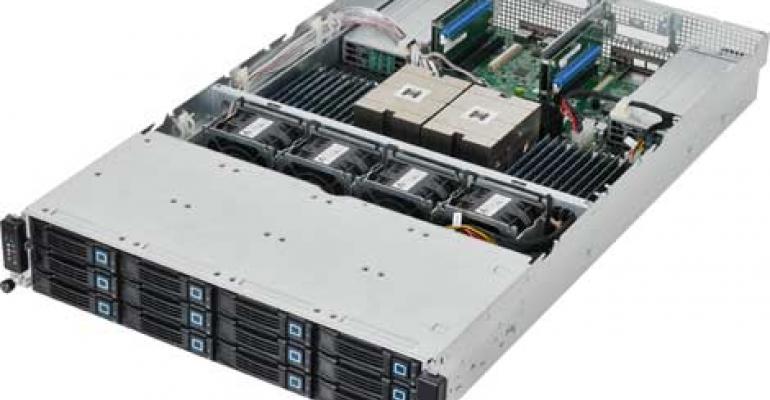
Here's a closer look at an AMD Open 3.0 server, a 3U unit built by Quanta Computer. (Photo: AMD)
If Facebook and the world's largest financial services companies got together to build a server, what might it look like? The answer can be seen in new servers being unveiled today based on the AMD Open 3.0 platform, which was developed through the Open Compute Project.
The hardware, which AMD calls "a radical rethinking of the server motherboard," will be on display today at the 2013 Open Compute Summit in Santa Clara, Calif. It is also being evaluated in data centers at Fidelity Investments and Goldman Sachs.
"This is big for AMD, big for customers and big for the data center," said Bob Ogrey, Cloud Technical Evangelist for AMD. "We're pretty excited. It's a paradigm shift in the server space. What's really important is that this is the first time a platform has been rolled out for Open Compute isn't targeted at Facebook's data centers."
Collaborating With the Financial Community
The Open Compute Project (OCP) was launched in April 2011 to publish data center designs developed by Facebook for its Prineville, Oregon data center. AMD 3.0 is an outgrowth of the first Open Compute Summit in New York in the fall of 2011, when technologists from AMD and several large New York financial institutions began discussing how to adapt the "open source hardware" designs for the financial community.
A prototype known as "Roadrunner," was demonstrated last May at the second Open Compute Summit in San Antonio. This year AMD is back with a refined platform that features multiple configurations for HPC, cloud computing and storage. AMD has built a new motherboard, which serves as the foundation for new servers built by original design manufacturers Tyan and Quanta Computer, which will then be marketed by systems integrators including Avnet Electronics Marketing and Penguin Computing.
“We became involved with the Open Compute Project very early as we saw a pervasive demand for simplified, energy efficient servers,” said Suresh Gopalakrishnan, corporate vice president and general manager, Server, AMD. “Our goal is to reduce data center power consumption and cost yet increase performance and flexibility– we believe that AMD Open 3.0 achieves this.”
Realizing Open Compute's Mission
“This is a realization of the Open Compute Project’s mission of ‘hacking conventional computing infrastructure,’” said Frank Frankovsky, Chairman of the Open Compute Foundation and VP of Hardware Design and Supply Chain at Facebook. What’s really exciting for me here is the way the Open Compute Project inspired AMD and specific consumers to collaboratively bring our ’vanity-free’ design philosophy to a motherboard that suited their exact needs.”
AMD Open 3.0, powered by the recently announced AMD Opteron 6300 Series processors, and can be installed in all standard 19-inch rack environments without modification, as well as Open Rack environments. The AMD Open 3.0 motherboard is a 16” x 16.5” board designed to fit into 1U, 1.5U, 2U or 3U rack height servers.
The motherboard features two AMD Opteron 6300 Series processors, each with 12 memory sockets (four channels with three DIMMs each), 6 Serial ATA (SATA) connections per board, one dual channel gigabit Ethernet NIC with integrated management, up to four PCI Express expansion slots, a mezzanine connector for custom module solutions, two serial ports and two USB ports. Specific PCI Express card support is dependent on usage case and chassis height.
“We have eagerly awaited the AMD Open 3.0 platform as it brings the benefits and spirit of the Open Compute Project to a much wider set of customers," said Charlie Wuischpard, CEO of Penguin Computing. "As we deliver a new line of Penguin servers based on AMD Open 3.0 and AMD Opteron 6300 processors, our high performance computing, cloud, and enterprise customers can now deploy application specific systems using the same core building blocks that are cost, performance, and energy optimized and perhaps most important, consistent. We think this initiative eliminates unnecessary complexity and provides new levels of supportability and reliability to the modern data center.”
Working Together With Intel
The effort led to unusual collaborations. The AMD team worked with rival Intel on standardizing components of the design, incouding the mezzanine connector. "In the 15 years that I've been doing servers, it's the first time we've got on the phone with the guys with Intel," said Ogrey. "That's pretty exciting."
The motherboard has a "T" shape to acommodate financial services firms' requirements for power supplies. Some place the power supply on the left, Ogrey said, while others place it on the right and still others have dual power size on either side for redundancy. The motherboard is shown below.






